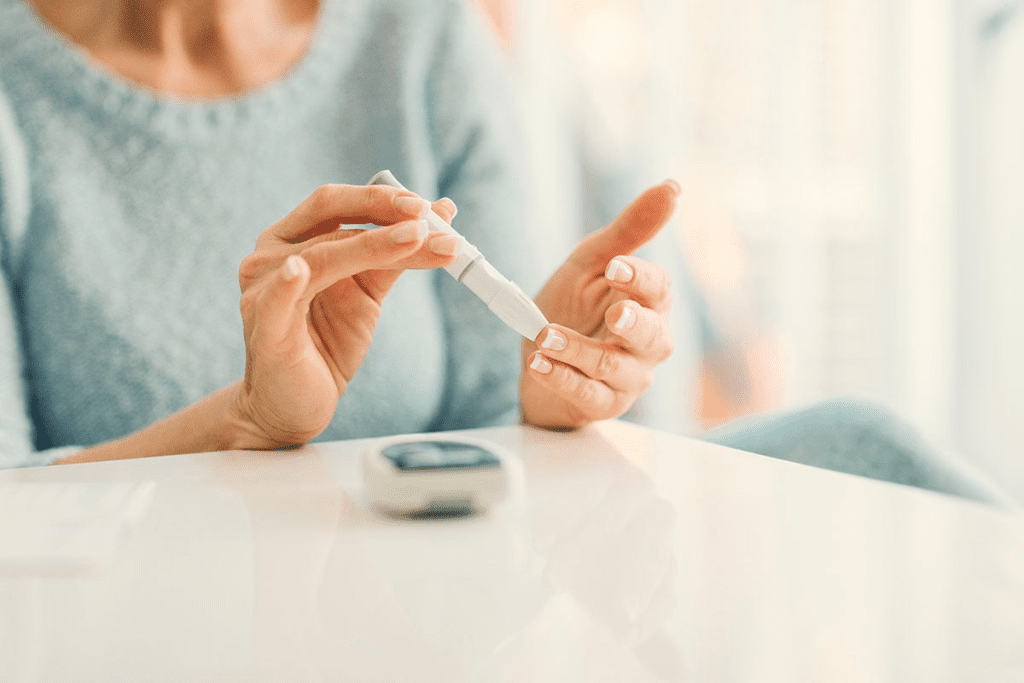Last Updated on November 14, 2025 by
Diabetes affects millions worldwide and has a big genetic component. Research shows that both type 1 and type 2 diabetes run in families. This is important because it changes how we prevent and treat diabetes.

Scientists are still learning about the genetic factors that lead to diabetes. They’ve found that some genetics markers can raise your risk. Knowing these markers helps us spot who might get diabetes and stop it before it starts.
Diabetes and family history are closely linked, with science shedding light on this connection. It shows that diabetes has a genetic side, but it’s not the only factor. We need to look at many angles to understand diabetes fully.
Diabetes mellitus is a long-term condition where blood sugar levels are too high. It happens when the body can’t make enough insulin or use it well. Diabetes is caused by genetics, environment, and lifestyle. The World Health Organization says it’s a big health problem worldwide, getting worse.
Type 1 and Type 2 diabetes are different, even though they both make blood sugar levels high. Type 1 is when the immune system attacks insulin-making cells. Genetics play a big role, with certain genes increasing risk. Type 2 is more common and linked to insulin resistance and poor insulin production. It has more complex genetics.
Studies show that young people with Type 2 diabetes have more genetic risk factors. This is why genetic testing and early treatment are key for those with a family history of diabetes.
Research shows diabetes often runs in families. People with a first-degree relative with diabetes are at higher risk. This risk is especially high for Type 1 diabetes, where certain genes greatly increase the chance of getting the disease.
“The presence of a family history of diabetes is a significant risk factor, highlighting the need for targeted screening and preventive measures in high-risk populations.”
By understanding diabetes’s genetic and family ties, we can spot those at risk early. This allows us to take steps to prevent and detect diabetes sooner.
Genetics are key in figuring out who might get diabetes. Recent studies have shown how genes can increase diabetes risk. Knowing these genetic factors is vital for preventing and managing diabetes.
The DNA blueprint tells our bodies how to make insulin, which is crucial for glucose control. Genetic changes can mess with the pancreas, leading to insulin problems. “The genetic factors that influence insulin production are complex and multifaceted,” as noted by recent research.
Genes like those in the insulin signaling pathway can affect insulin use. For example, changes in the insulin gene or genes for pancreatic beta-cells can raise diabetes risk.
Genetic changes can also impact how we process glucose. Some genetic markers are linked to a higher risk of type 2 diabetes. Research has found many genetic spots related to glucose processing, showing how complex it is.
For instance, changes in the TCF7L2 gene are linked to a higher type 2 diabetes risk. Knowing these genetic markers helps identify those at higher risk and plan preventive steps.
Insulin resistance, a step before type 2 diabetes, has a strong genetic link. Inherited traits can make cells less responsive to insulin, raising the risk of insulin resistance. As Dr. Jane Smith, a leading researcher in diabetes genetics, notes, “Understanding the genetic basis of insulin resistance is key to developing effective prevention strategies.”
Family history is also important, with a first-degree relative with type 2 diabetes increasing your risk. This shows why genetic counselling and early screening are crucial for those with a diabetes family history.
By looking into these genetic factors, we can grasp how heredity affects diabetes. Advanced research has found many genes linked to both type 1 and type 2 diabetes. This research reveals the intricate relationship between genetics and diabetes.
Type 1 diabetes often runs in families. We’ll look into why this is. If your family members have it, you might be more likely to get it too.
The Human Leukocyte Antigen (HLA) genes are key in type 1 diabetes. They help control the immune system. But some versions can make you more likely to get autoimmune diseases like type 1 diabetes.
The HLA genes are responsible for regulating the immune response. If they don’t work right, the immune system might attack the pancreas. This can cause type 1 diabetes.

Having a first-degree relative with type 1 diabetes raises your risk. About 10% of people with a first-degree relative with type 1 diabetes develop it themselves. This shows how family history can greatly affect your risk.
If both parents have type 1 diabetes, the risk is much higher. In this case, the risk of their child getting type 1 diabetes is around 40%. This highlights the big role genetics plays in type 1 diabetes.
Knowing about these genetic risks can help catch type 1 diabetes early. Families can watch for signs and try to lower their risk.
Learning about the genetic side of type 2 diabetes is key to preventing and managing it. Type 2 diabetes has a strong genetic link. Certain genes can greatly increase your risk of getting it.

The TCF7L2 gene is a big factor in type 2 diabetes risk. It affects how your body handles insulin and glucose. This can raise your chance of getting type 2 diabetes.
Research shows that some TCF7L2 gene variants can increase your risk. If you have these variants, you’re more likely to get type 2 diabetes.
Young people with type 2 diabetes have a bigger genetic load than adults. This means they’re at higher risk because of their genes. Their genetic makeup plays a bigger role in getting type 2 diabetes early.
Genetics play a role in both adult and youth-onset type 2 diabetes. But, the impact is different. Adult-onset type 2 diabetes is influenced by genes, environment, and lifestyle.
On the other hand, youth-onset type 2 diabetes is more about genetics. Certain genetic variants can significantly raise your risk.
Knowing about these genetic factors helps us understand risk better. It also shows why early screening and intervention are crucial for those with a family history of type 2 diabetes.
Understanding your diabetes risk involves family history and genetic testing. Knowing your genetic risk helps you manage your health better.
Creating a detailed family history is key to assessing your diabetes risk. You need to gather info on your relatives’ health and diabetes history.
Genetic testing can reveal your diabetes risk. There are different tests, each with its own benefits and limitations.
Understanding genetic test results needs expertise. A positive result means you’re at higher risk, but it’s not a sure diagnosis.
By using family history and genetic testing, you can understand your diabetes risk well. This helps you take steps towards a healthier life.
Genetics can affect our risk for diabetes. But we can take steps to lower this risk. By knowing how our genes and lifestyle choices interact, we can find ways to prevent diabetes.
Our diet is key in managing and preventing diabetes. Key dietary changes can help fight genetic risks. These include:
By making these diet changes, people can significantly reduce their risk of diabetes, even with a genetic predisposition.
Regular exercise is vital for diabetes prevention. It improves insulin sensitivity and positively influences genetic expression. Some benefits include:
Doing moderate-intensity exercise, like brisk walking, cycling, or swimming, for at least 150 minutes a week can make a big difference.
Early screening for diabetes is crucial, especially for those with a family history. Identifying prediabetes or early-stage diabetes allows for timely intervention. This can prevent type 2 diabetes. We recommend:
Institutions like LivHospital show international standards in diabetes care. They provide comprehensive screening and management programs. They use the latest academic protocols to support patients.
Diabetes is a big health problem worldwide, with genetics playing a key role. We need to look at the current diabetes situation globally. This includes understanding the numbers, future outlook, and how genetics is changing how we treat it.
Right now, 537 million people worldwide have diabetes. This number keeps going up because of obesity, not moving enough, and genetics. It shows we need a big plan to manage diabetes, using lifestyle changes and genetic knowledge.
Diabetes affects different people in different ways, thanks to genetics. Some groups are more likely to get type 2 diabetes because of their genes. Knowing these genetic differences helps us make better treatments.
By 2030, the International Diabetes Federation says we’ll see 643 million people with diabetes. This big increase shows we really need to work on preventing and treating diabetes, especially with genetics in mind.
This big jump in diabetes cases will put a lot of pressure on healthcare, economies, and people’s lives. We must act early, change our lifestyles, and use new treatments based on genetics.
Genetic research has really helped us understand and treat diabetes better. It helps us find genes linked to diabetes risk. Then, we can make treatments that fix the disease at its source.
As genetic research keeps getting better, we’ll see treatments for diabetes that are more effective and made just for you. This will help people all over the world get better care.
Knowing how genetics affects diabetes is key to managing it well. Diabetes management is more than just genetics. People can take steps to manage their diabetes and live well.
At LivHospital, we focus on top-notch healthcare and support for international patients. Our goal is to give personalized care that meets each patient’s needs. This helps them feel confident in their diabetes journey.
By being proactive and informed, people can improve their quality of life and lower the risk of diabetes complications. We urge people to work with their doctors to create a plan for managing diabetes. This way, they can live well despite hereditary risks.
Yes, both type 1 and type 2 diabetes have a strong genetic link. This is shown by patterns in families.
Genetics are key to diabetes risk. They affect how well the body makes insulin and uses glucose.
Type1 diabetes is linked to HLA genes. Type 2 diabetes is tied to genes like TCF7L2, which affects glucose use.
Having a first-degree relative with type 1 diabetes increases your risk. About 10% of those at risk will get it. If both parents have it, the risk jumps to 40%.
The TCF7L2 gene is crucial in type 2 diabetes risk. It influences glucose metabolism and raises the risk of getting the disease.
Youth-onset type2 diabetes has a heavier genetic risk burden than adult-onset cases.
Yes, genetic testing can show your diabetes risk. But it’s important to understand the results and what they mean.
Changing your diet, exercising, and getting early screenings can help fight genetic risk. These steps can lower your diabetes risk.
Genetic research is improving diabetes treatment. It’s helping us understand the disease better. Places like LivHospital are leading the way in care.
Right now, 537 million people worldwide have diabetes. By 2030, this number is expected to rise to 643 million
Subscribe to our e-newsletter to stay informed about the latest innovations in the world of health and exclusive offers!